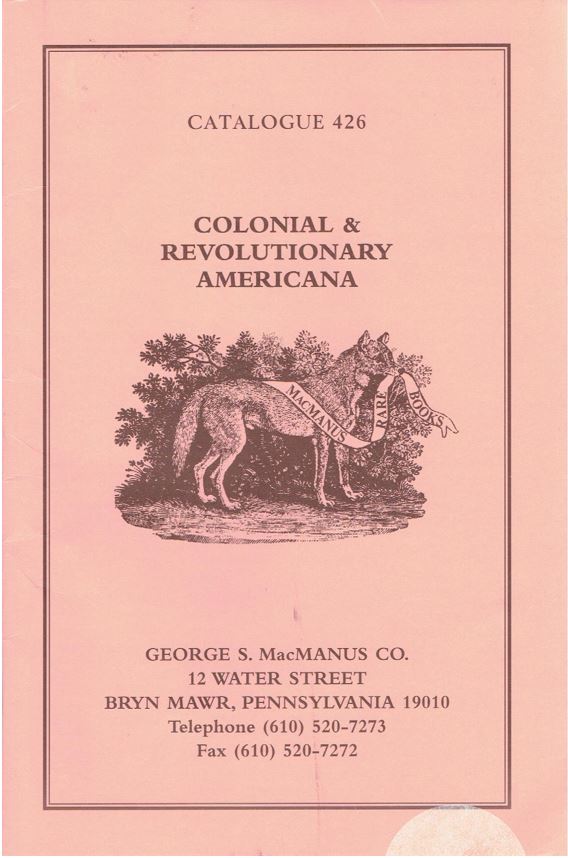Colonial & Revolutionary Americana from the George S. MacManus Company
- by Michael Stillman

Colonial & Revolutionary Americana from the George S. MacManus Company
The George S. MacManus Company has published their Catalogue 426. Colonial & Revolutionary Americana. We find material from the days when no one questioned the American colonies were part of Britain, to the early days when some Americans began to question whether their freedoms were being recognized, to the time of outright hostility, followed by revolution, and finally, a new nation. While there are some later accounts, most of what we find is contemporary accounts by people living those times. The world has not been the same ever since. Here are a few selections
One of the early leaders in the fight against unjust colonial laws was Josiah Quincy Jr. of Massachusetts, a distant relative of John Quincy Adams. He argued against the Intolerable Acts, and in this case in particular, the “Boston Port Bill.” This is the one that closed the Port of Boston until the colonists paid for the losses incurred from the Boston Tea Party. Quincy's position is presented in Observations on the Act of Parliament, Commonly Called the Boston Port Bill; with Thoughts on Civil Society and Standing Armies, published in 1774. He condemns Parliament for punishing the whole community because of the acts of a few. He also argues against standing armies, calling them “armed monsters.” Naturally, the standing army in America was the British army, which was increasingly being used to repress the local residents. In 1774, he travelled to Britain to argue the colonists' cause before sympathetic politicians, but on the way back, he succumbed to illness. Josiah Quincy Jr. did not live to see the Revolution. Item 133. Priced at $12,500.
Not surprisingly, the Declaration of Independence was not well-received in England. One person who was not impressed was John Lind, a barrister and friend of Jeremy Bentham, who identified him as the author of this anonymous tract: An Answer to the Declaration of the American Congress, published in 1776. This is a fourth edition but the same year as the first. It must have been popular in his homeland. Lind goes through point by point the claims in the Declaration and derides the document as “absurd & visionary.” His comments drip with contempt, saying the King cannot respond as it would be beneath his dignity to answer such “simple individuals.” He described the Declaration as an insult to all British citizens. Item 27. $2,000.
If you are looking to find gold or other valuable minerals, this book should help: A Discovery of Subterranean Treasure. Containing Useful Explorations, concerning all manners of Mines and Minerals, from the Gold to the Coal, with plain directions and Rules for the finding of them in all Kingdoms and Countries. The author was Gabriel Plattes, an expert on mining, metallurgy, and agriculture. This is a rare first American edition of 1784 of a book originally published in the 17th century. Plattes explains some of the geologic processes that form deposits (or where he was stumped, blamed it on Noah's flood). He speaks about mines in Peru, New England, Virginia and other places. He claims to have found a process to produce pure gold, but at a cost more than its worth. While providing rules on finding gold in all countries, Plattes seemed not to have followed them himself as he died on the streets of London in poverty. Item 122. $4,000.
This book is probably the best look at colonial America in the 17th century, at least the northern part of what became the United States. The title is Magnalia Christi Americana: or, the Ecclesiastical History of New-England, from Its First Planting in the Year 1620, unto the Year of Our Lord, 1698. Published in 1702, the author was America's most noted clergyman of his era, Cotton Mather. Mather was a stern Puritan, a man whose reputation was forever tarnished by his association with the Salem Witch Trials. Despite this, and the description of the book as a “ecclesiastical history,” it is much more. It covers all aspects of life and the history of the colonies from the time of the landing of the Pilgrims almost to the end of the century. It provides a detailed look at what life was like in those days, including civil, political, and other non-religious activities. According to Streeter, it is “the most famous American book of colonial times.” Item 49. Priced at $10,000.
Cotton's father, Increase, was also a notable clergyman in early New England. He was not quite as stern as his son though not necessarily a whole lot better. But, he too had interests beyond the religious role for which he is most remembered. He was interested in science, not seeing it necessarily contradictory to theology. Item 50 is Increase Mather's Kometographia; or a Discourse Concerning Comets... published in 1683. The work was spurred on by the appearance of Halley's comet the previous year. The book includes his sermons Heavens Alarm to the World and The Latter Sign, which try to reconcile the appearance of comets with religious faith. However, in Kometographia, he focuses more on scientific observations. That is not to say he doesn't still try to combine the science with religion, as most, including Newton, did, but he goes well beyond a simple religious explanation. $25,000.
The George S. MacManus Co. may be reached at 610-520-7273 or books@macmanus-rarebooks.com. Their website is www.macmanus-rarebooks.com.